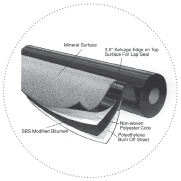Modified bituminous flexible membrane systems are composite sheet membranes that consist of asphalt bitumen (modified), reinforcement, and surfacing materials. The membranes are supplied in rolls which are commonly 1 m (39 in) wide and 8 m to 15 m (26 ft to 50 ft) long.
Modified bitumen membranes consist of a reinforcing mat that is impregnated and coated with polymer-modified asphalt and may be surfaced with mineral or synthetic granules, polymeric film or coating on the weather side.
The asphalt used in these membranes is modified by the addition of chemical compounds called polymers. These compounds give the asphalt more flexibility, a greater ability to stretch, and make them more weather resistant. The two most common polymers used to modify the asphalt are styrene butadiene styrene (SBS) and atactic polypropylene (APP). SBS membranes may be applied by adhering with cold-applied adhesives, torching, mopping with hot applied asphalt bitumen, or mechanically fastening. APP membranes may be adhered with cold-applied adhesives, torched-on, or mechanically fastened.
 The type of reinforcing that is use in a product depends on the end use and desired physical properties of the finished products. The most common reinforcements used in these membranes are:
The type of reinforcing that is use in a product depends on the end use and desired physical properties of the finished products. The most common reinforcements used in these membranes are:
- Non-woven spun-bonded polyester
- Woven polyester scrim
- Fiberglas mat
- Woven fibreglass cloth
- Combinations of the above
Modified bitumen membrane systems typically consist of two plies, a membrane base sheet and a membrane cap sheet.
Modified bitumen membrane base sheets and the underside of membrane cap sheets are typically surface treated with a parting agent so they do not stick in the roll. Depending on the particular roof system being installed, the surfaces of membrane base sheets and the underside of membrane cap sheets may have a sanded surface or a thermofusible plastic film. It is important to distinguish between membrane surfacings as materials with thermofusible film are not typically suitable for mop application.
The top or weather surfaces of membrane cap sheets may be surfaced with mineral granules (usually ceramic chips or slate flakes), polymeric film or metallic foil, or may have an elastomeric coating field applied for ultra-violet protection. As an alternative on low sloped roofs, a pour coat of asphalt bitumen and gravel surfacing may be installed over some membranes.
As with all flexible membranes, the quality of the installation is critical to the performance of modified bituminous membranes. Although some of the application techniques for these membranes are similar to those employed in built-up roofing and the materials can be “familiar”, the differences are critical. It is important that the specifications, details, and installation techniques all conform to the membrane manufacturer’s requirements.
